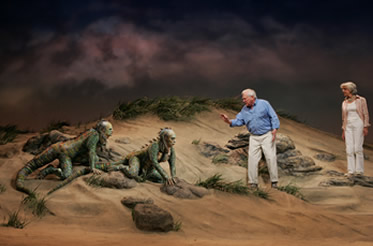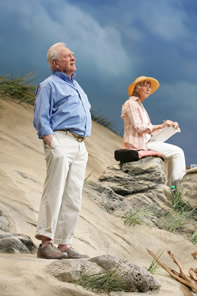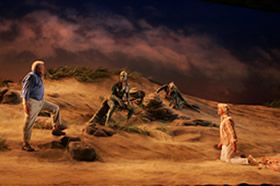
Beyond Landscape
By Una Chaudhuri
Seascape
By Edward Albee
Booth Theatre
222 W. 45th St.
(closed)
The recent New York production of Edward
Albee's Seascape--which accomplishes the unlikely feat
of getting two talking lizards onto a Broadway stage in a play
that is neither a musical nor a children's entertainment--has
been appreciated as an elegant and urbane entertainment in many
reverential reviews, which read it essentially as a portrait of
a marriage. In fact, there is much more in it, which a comment
I overheard during intermission suggests is not being lost on
ordinary spectators: "Doesn't it make you think of this whole
Intelligent Design thing that's going on?"
Seascape is one of three Albee
plays whose titles signal their interest in literary modes and
genres. The earliest was The Zoo Story, which staged
the power and limits of narrative through the unforgettable "Story
of Jerry and the Dog." The most recent was The Play about
the Baby, which slyly revealed the subtle terrorism involved
in making lives into plays. Seascape, written in 1975
and recently revived by Lincoln Center at the Booth Theatre in
a production directed by Mark Lamos, transposes the elements of
drama--including several vintage Albee themes and character-types--into
the representational frame of landscape.
The genre of landscape first enjoyed a
rich history in painting, followed by a second complex life in
association with such practices as the design of parks and gardens,
environmental policy, public architecture, and the spatial representation
of national identity. This reframing of landscape--from (as it
were) a small picture to a big one--is part of the subject of
a critical field known as Landscape Studies, which has emerged
and flourished in the years since Albee wrote his play. Landscape
Studies offers a way to respond to the invitation embedded in
Albee's title, and to take his formal interest seriously. The
suffix "scape," while phonically evoking a notion--"escape"--that
Albee's play mines fully, also posits a unifying point of view,
a perspective from which the figures in the landscape are no more
interesting and meaningful than the world they inhabit.
The set design of the current production,
by Michael Yeargan, does justice to the genre of landscape as
it is understood today: a culturally overdetermined transformation
of a piece of land into a set of meanings. The slice of environment
in this case is a sun-soaked beach, rendered here as a vast swath
of golden sand stretching across the stage and rising to almost
half its height. Framed by the Booth's proscenium arch, this deceptively
simple set becomes hugely resonant. First, its cultural meanings
are heightened and indexed by the opening dialogue, where the
fantasy of a lifetime of beach-combing, free from the cares of
life and work, features prominently: "Can't we stay here forever?"
To these familiar associations the action of the play adds a second,
more archetypal layer: the beach as no-man's land, social border
and human limit, place of ends and beginnings, and the extreme
verge of life for most animals, whichever side of it they inhabit.
 The
two animals discovered lounging on this evocative expanse of earth
turn out to be the aforementioned vintage Albee types: hyper-cultivated
WASPS who would never allow their fitful search for the meaning
of life to interfere with the opportunity to deliver a shapely
witticism. Charlie and Nancy are a benign version of old George
and Martha, this time amply supplied with satisfactory progeny
(so they say), and basking in the warmth of their plump retirement
funds. Their conversation reveals a relationship full of affectionate
amusement, with just a touch of discontent smoothed over with
rueful toleration. Played with deep yet ironic humanity by George
Grizzard and Frances Sternhagen, Charlie and Nancy are ideally
suited to the role Albee has in mind for them: explorers of the
human verge.
The
two animals discovered lounging on this evocative expanse of earth
turn out to be the aforementioned vintage Albee types: hyper-cultivated
WASPS who would never allow their fitful search for the meaning
of life to interfere with the opportunity to deliver a shapely
witticism. Charlie and Nancy are a benign version of old George
and Martha, this time amply supplied with satisfactory progeny
(so they say), and basking in the warmth of their plump retirement
funds. Their conversation reveals a relationship full of affectionate
amusement, with just a touch of discontent smoothed over with
rueful toleration. Played with deep yet ironic humanity by George
Grizzard and Frances Sternhagen, Charlie and Nancy are ideally
suited to the role Albee has in mind for them: explorers of the
human verge.
Albee's affinity with Beckett is well-known
(and was recently explored when three Beckett shorts were paired
with Albee's Counting the Ways at The Century Center
in New York City). The setting of Seascape, an expanse
of sand, suggests another echo: the unexplained and unforgettable
abode of the loquacious Winnie in Happy Days. The dialectic
of movement and immobility Beckett explored in that play has undergone
a gender-switch in Seascape: Nancy, with all her talk
of travel, adventure and change, is the one associated with movement,
while Charlie yearns for stillness. But the key resemblance to
Beckett remains: the everyday absurd is finely calibrated with--set
within, resonant with, ironized by--the philosophical sublime.
In Albee's case, this sublime has a biological, even evolutionary
inflection: absurdity stirred into, as it were, the primordial
soup.
The opening conversation consists of vague
planning, gentle disagreements, and some surprising reminiscing.
Details about Charlie's childhood game of sitting at the bottom
of the ocean give the plot the gentle shove it needs to tip over
from its familiar little world into a very different and strange
one. When Charlie and Nancy are joined by Leslie and Sarah, the
English-speaking reptile couple, Albee's little landscape suddenly
becomes a very big picture indeed.
Leslie and Sarah are played with such absolute
assurance and complete embodiment by Frederick Weller and Elizabeth
Marvel, and so brilliantly costumed by Catherine Zuber, that one
watches their every move with a mixture of admiration and alarm,
fascination and fear. The encounter of the human and non-human
animals turns out to be not only hugely entertaining--suspenseful,
funny, moving, surprising--but also one of the most unexpectedly
respectful ever imagined by a writer. As the two couples quiz
each other about the nature of their lives, venturing into intimate
topics that produce both amusing biological information and strong
emotional responses, the stage begins to move back and forth between
the "small world" preoccupations of its characters--love and marriage,
offspring and obligation, pride and prejudice--to decidedly "big
picture" considerations that rarely make their way into theater.
More on this in a moment.
Animal references in the theater are often
quickly translated into allegory, either by the playwright or
the spectator/critic: thus Ionesco's rhinoceroses are read as
fascists, Shaeffer's horses as paganism, Ibsen's wild duck as
freedom, Chekhov's seagull as art. In Seascape, the slide
into allegory is arrested by being explicitly acknowledged: when
Leslie's comments about other sea creatures begin to sound familiarly
racist, Charlie cries out, incredulously, "You're a bigot!" The
temptation to read the reptile couple as typical members of another
social group, with characteristic chauvinism and intolerance,
is short-circuited, because that thought is immediately portrayed
as superficial and insufficient. Interestingly, Albee performed
a similar evasive maneuver in The Goat, preempting the
equation of bestiality with homosexuality by providing his goat-loving
protagonist with an openly and unproblematically gay son.
 So
far is Albee from wanting to abandon his animal characters to
a reductively allegorical fate that he had originally planned
to transport the entire play into their world: as he mentioned
in a recent interview, the first draft of Seascape had
three acts, one set underwater! Though later excised, this astonishing
idea has left its mark on the play. For the inter-species encounter
it stages is also a meeting of worlds, landscapes, ontologies.
While owning up to--and brilliantly dramatizing--the seduction
of human personalities, with all their pettiness and weightiness,
Seascape also manages to open a space around them. This
space--one might call it an ecological setting--subtly but profoundly
alters the human story, redrawing it to a scale which reveals
unexpected patterns and enjoins a new ethics.
So
far is Albee from wanting to abandon his animal characters to
a reductively allegorical fate that he had originally planned
to transport the entire play into their world: as he mentioned
in a recent interview, the first draft of Seascape had
three acts, one set underwater! Though later excised, this astonishing
idea has left its mark on the play. For the inter-species encounter
it stages is also a meeting of worlds, landscapes, ontologies.
While owning up to--and brilliantly dramatizing--the seduction
of human personalities, with all their pettiness and weightiness,
Seascape also manages to open a space around them. This
space--one might call it an ecological setting--subtly but profoundly
alters the human story, redrawing it to a scale which reveals
unexpected patterns and enjoins a new ethics.
In a special issue of the journal Performance
Research on animals and performance in 2002, guest editor
Alan Read asked the question: "What might it mean to practice,
think, and write theater beyond the human?" Seascape
is one answer. Among its discoveries is the recognition of a new
time-span for realistic drama--one that vastly surpasses the usual
limit of two or three human generations. Though the two couples
talk of their childhoods and youths, their children and their
future, the obvious difference between them bespeaks a much longer
time-table. The ethics of this evolutionary schedule are made
explicit in the last few moments, when the human couple promises
to "help" the others to succeed in the next phase of their existence,
on land. The creatures, returning from the verge of retreat, accept
the offer of help. The last line of the play is a single resonant
word, spoken by Leslie: "Begin."
The new beginning is hardly imaginable
but remarkably resonant. Nancy, who had earlier on admitted that
she couldn't "resist slipping into the past tense," and Charlie,
who thought longingly of a watery oblivion, are invited--commanded--to
alter their default temporality, and to regard themselves as implicated
in a future no less than they are defined by their past. That
future, it seems, requires them to think beyond the human, and
to offer aid and assistance to lives they have been accustomed
to ignoring. It requires them to move from being mere figures
in a landscape to being the co-creators, with other figures--however
improbable--of a landscape imbued with a new environmental ethics.
